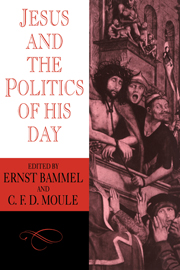Book contents
- Frontmatter
- Contents
- Abbreviations
- Foreword
- The Zealots and Jesus
- The revolution theory from Reimarus to Brandon
- The date and character of Mark
- Some observations on Tendenzkritik
- Argumentum e silentio
- The Poor and the Zealots
- The opposition between Jesus and Judaism
- Judaeo-Christianity and the Jewish establishment, A.D. 33–66
- A.D. 70 in Christian reflection
- The trial of Jesus in the Acta Pilati
- Christ as brigand in ancient anti-Christian polemic
- Jesus as a political agent in a version of the Josippon
- The Feeding of the Multitude
- The coin of ‘Render unto Caesar …’ (A note on some aspects of Mark 12: 13–17; Matt. 22: 15–22; Luke 20:20–26)
- Render to Caesar
- The Temple tax
- ‘Not peace but a sword’: Matt. 10:34ff; Luke 12: 51ff
- The decision of the Supreme Court to put Jesus to death (John 11:47–57) in its context: tradition and redaction in the Gospel of John
- The ‘triumphal’ entry
- The two swords (Luke 22: 35–38)
- The titulus
- Romans 13
- Biblical criticism criticised: with reference to the Markan report of Jesus's examination before the Sanhedrin
- The political charge against Jesus (Luke 23: 2)
- The trial before Pilate
- ‘His witness is true’: A test of the Johannine claim
- Index of Authors
- Index of References
‘Not peace but a sword’: Matt. 10:34ff; Luke 12: 51ff
Published online by Cambridge University Press: 19 January 2010
- Frontmatter
- Contents
- Abbreviations
- Foreword
- The Zealots and Jesus
- The revolution theory from Reimarus to Brandon
- The date and character of Mark
- Some observations on Tendenzkritik
- Argumentum e silentio
- The Poor and the Zealots
- The opposition between Jesus and Judaism
- Judaeo-Christianity and the Jewish establishment, A.D. 33–66
- A.D. 70 in Christian reflection
- The trial of Jesus in the Acta Pilati
- Christ as brigand in ancient anti-Christian polemic
- Jesus as a political agent in a version of the Josippon
- The Feeding of the Multitude
- The coin of ‘Render unto Caesar …’ (A note on some aspects of Mark 12: 13–17; Matt. 22: 15–22; Luke 20:20–26)
- Render to Caesar
- The Temple tax
- ‘Not peace but a sword’: Matt. 10:34ff; Luke 12: 51ff
- The decision of the Supreme Court to put Jesus to death (John 11:47–57) in its context: tradition and redaction in the Gospel of John
- The ‘triumphal’ entry
- The two swords (Luke 22: 35–38)
- The titulus
- Romans 13
- Biblical criticism criticised: with reference to the Markan report of Jesus's examination before the Sanhedrin
- The political charge against Jesus (Luke 23: 2)
- The trial before Pilate
- ‘His witness is true’: A test of the Johannine claim
- Index of Authors
- Index of References
Summary
Quoted out of context – as they often are – these verses seem more appropriate to the Qur'an than to the Gospels; they sound like a cry of Muhammad proclaiming a Jihad or holy war, rather than a genuine utterance of the Prince of Peace.
Their context in the Gospels, however, is important if we are to seek to understand their original meaning. They are found in the ‘double tradition’, the source Q – which seems to have weathered continuous criticism – and appear in a variant form in Luke: ‘do you suppose I came to establish peace on earth? No, indeed, I have come to bring division’ (NEB) (διαμεϱιoμóν for μάχαιϱαν ‘sword’). In both Matthew and Luke this saying is followed by an adaptation of Mic. 7: 6,2 so that, for the common source of both evangelists, the conflict of division, which Christ here declares he had come to bring, was not one within nations, or even within a single nation, but within families – a situation all too familiar in Christian missionary history. Although omitted by Matthew, Luke 12: 49 contains a similar kind of saying (‘I came to cast fire upon the earth …’) which, there is good reason to think, comes from the same source (Q) and which certainly occurs in the same logia-group (Luke 12:49–53), so that any interpretation of Matt. 10: 34 par. would then require to take some account of its twin-saying at Luke 12:49.
- Type
- Chapter
- Information
- Jesus and the Politics of his Day , pp. 287 - 294Publisher: Cambridge University PressPrint publication year: 1984
- 3
- Cited by



